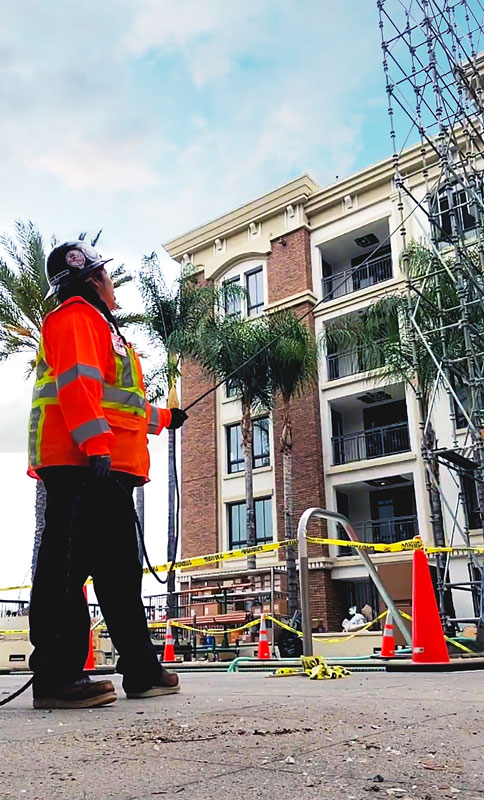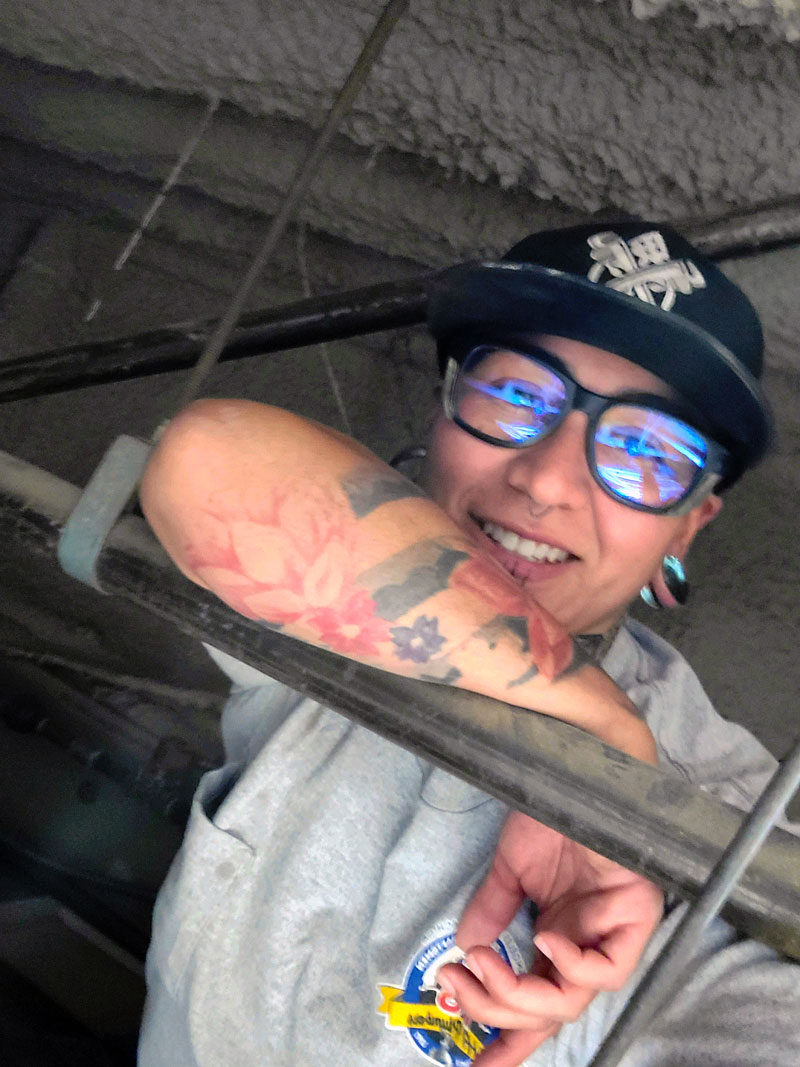
Patricia Contreras could hardly believe her ears.
She had just begun working at a large construction project in Los Angeles and being the only woman on the job site, inquired about the restroom facilities.
“The project manager told me, ‘Hey, if you need to use the restroom, just walk down to the shopping center,’ which was down the street,” she said. “And I was like, ‘I cannot tell my boss, ‘Hey, I’ll be back; I’m going to Ralphs just to use the restroom.”
Though perhaps more extreme than most, Contreras’ experience is consistent with the results of a recent survey in which nearly two-thirds (64%) of women cited the absence of gender-friendly restroom facilities at construction sites.
Lumber, a pioneering construction workforce management platform tailored for construction contractors, conducted a ratings-based survey of more than 100 tradeswomen, construction owners, and industry executives for the “She Builds Nation: The Business Case for Supporting Women in Construction” report.
A fourth-year plumbing apprentice at UA Local 761 in Burbank, California, who primarily works on large construction sites, Contreras said she is typically the only female plumber. When there is a sign designating the portable restroom as being for women, she said men will often learn the access code and use it because they know it will be cleaner and better stocked than the others.
“I wouldn’t mind, but I don’t need a dirty urinal in my face when I use the bathroom,” she said. “Or honestly if they would just act human and use it for its intended purpose and exit afterward. I don’t understand how someone could rip off a toilet seat when using the bathroom.”
Fortunately, other women have had better experiences.



PHOTOS COURTESY OF PATRICIA CONTRERAS
Stephanie Mendias, who recently completed her plumbing apprenticeship at UA Local 78 in Los Angeles, said she increasingly sees more women on her crews, and they have a designated portable restroom.
“Since there are more women coming onto the job site, I am having to share it with multiple women,” she said, “which isn’t an issue because it’s a lot cleaner than the other ones.”
In her experience, general contractors typically allow them to use the restrooms in their offices, if necessary, but that can be an issue given how far they can be from where they’re working.
Mendias said she sometimes bounces around from one site to another, but when it becomes clear that she will be at one for a while, they are good about ordering one for her when necessary.
“Usually they already know,” she said. “They’re like, ‘Oh, we need to get you a restroom.’ Luckily, I’ve been fortunate that it hasn’t been an issue for me to not have my own facilities to use.”
However, the overall lack of bathroom maintenance can be an issue on some jobsites.
“Sometimes the men also complain about the way the facilities are being kept up,” Mendias said. “It sucks for both of us if they’re not being cleaned regularly. Sometimes they get torn up because homeless people will break in, or they just don’t keep up with the cleaning.”
The report examines critical issues women face in the construction industry and advocates for greater support and inclusivity within the construction ecosystem.
In addition to gender-friendly restrooms, the survey asked about the availability of gender-friendly safety equipment such as PPEs, safety harnesses and hard hats.
Two-thirds of respondents (67%) said gender-friendly safety equipment is not available at construction sites; Contreras and Mendias agreed.
Mendias said PPE, including helmets, vests, gloves and harnesses, is typically provided. However, while female-specific fall protection harnesses are available on the market, she said she has never seen them; instead, she uses the training they receive to adjust harnesses the best she can.
Contreras said in her experience, on the rare occasions when the company provides such harnesses, men will often grab them before she has the opportunity to do so.
“Guys will say, ‘Oh, I need this,” or “I’ll bring it right back,” and you can’t just leave your spot to go find it or hunt it down,” she said.
“There may be one women’s harness available, but it’s not really completely available to us.”


While indicating there is room for improvement when it comes to providing gender-friendly restrooms and equipment, the survey provided a positive outlook for women in the trades:
• 72% believe there are opportunities for women’s advancement within the industry
• 68% agree there is access to training and professional development for women
• 67% found integrating within a male- dominated industry culture to be easy
• 66% say there is potential for women to thrive in entrepreneurship within the industry; and
• 63% said they were able to overcome stereotypes and earn respect in the industry.
Contreras and Mendias both agreed that despite issues with restrooms and equipment, they are optimistic about their futures in the plumbing industry and the opportunities they will have.
Contreras joined the trades in March 2020 at the beginning of the COVID-19 pandemic after spending more than a decade as a dog groomer. She also has an accounting certificate, but was looking for something that was more hands-on and could lead to a long, successful career.
She has no doubt there will be opportunities for advancement.
“Absolutely,” Contreras said. “I think it just takes some time. Anything with the trades, you have to put in your own work. So even if there are a lot of obstacles, there are still a lot of events and networking opportunities.
Especially with IAPMO — there are the meetings and events they post, and all that really helps as long as we put in the work.”
Contreras attends North America’s Building Trades Unions’ (NABTU) Trades Women Build Nations Conferences, which provides the opportunity to talk to women from other states who are in similar situations, and not only in the plumbing trade.
“You see each other’s struggles, you see each other’s wins and gains,” she said.
“And then you can communicate and connect there.”
Contreras is also a member of two IAPMO chapters. While the UPPA chapter in Long Beach is her primary one, she also attends the California Southern P/M (CASPM) chapter.
She specifically credits IAPMO Field Services Manager Iggy Contreras, whom she met when she was a general foreman on one of her job sites, with helping her early in her career.
“At our chapter Iggy strongly encourages we women to be involved,” she said. “He introduces us to a lot of folks who are in higher positions on jobs, from local to local, so we get to know each other and familiarize ourselves with each other so that once we get to the job sites it makes it that much easier.”
Mendias said she sees opportunities for advancement through her local and her involvement with IAPMO. She said now that more women are joining the trade, there has been an increased focus on letting women know they, too, can become project managers and instructors.
She first attended a Trades Women Build Nations Conference when she was a second-year apprentice, and said coming from a job site where she was the only woman and then hearing others had also been on the receiving end of unwanted comments helped her realize she was not alone. She also likes it because it provides a valuable opportunity to learn about available resources and opportunities.
Mendias said when she was new, she sometimes felt as though she was being tested on job sites just because she was a woman. However, as time goes on and she continues to prove herself, she has increasingly gained her co-workers’ respect. And as more women enter the trades, such testing applies to men and women.
“I feel like it applies to everybody now,” she said, “because there are a lot more women coming onto the job site, not just with plumbers, but electricians, there are iron workers out there, there are cement masons out there. A lot of women are choosing different career paths and I feel like kind of all of us have to go through it, and not just women. I feel like men do, too.”
Lumber CEO and Founder Shreesha Ramdas said the report serves an important purpose.
“In unveiling the ‘She Builds Nation’ report, we’re not just shedding light on the challenges faced by women in construction; we’re igniting a conversation and catalyzing action toward a more inclusive, equitable industry.”
Mendias said the industry’s inclusion and acceptance of women is slowly but surely moving in the right direction.
“It’s been male dominant for so long that we can’t expect change to happen overnight, but I do see change happening,” she said.

Mike Flenniken is a staff writer, Marketing and Communications, for IAPMO. Prior to joining IAPMO in 2010, Flenniken worked in public relations for a group of Southern California hospitals and as a journalist in writing and editing capacities for various Southern California daily newspapers.
Last modified: August 30, 2024
